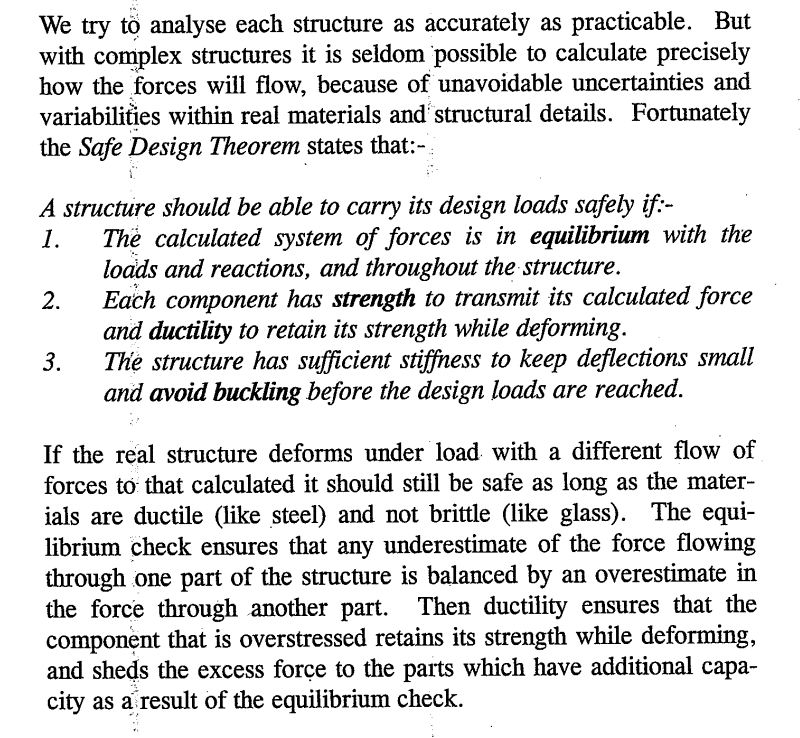ZeroStress
Structural
Hello
I'd be grateful if someone could shed some light on my problem which is keeping me awake through the nights.
I am assessing a bridge deck and its construction is RC deck (280mm thick) spanning between the abutments (span is 7m). Fairly simple deck. The concrete is of 20.7N/mm2 strength. Here is the cross section of it. [URL unfurl="true"]https://imgur.com/dmCitvq[/url]
I am using a FE software (LUSAS) to analyse the deck by modelling the deck as thick shell.
The main rienforcement (longitudinal) is 22mm @ 150 CRS and the transverse reinforcement is only 10mm @ 300 CRS. As you can see the transverse reinforcement is pretty small. In accordance with British standards (dmrb CS 454), the longitudinal bending capacity would be 95kNm and the transverse bending capacity would be 9kNm.
Now, I want to model the deck in such a way that the stiffness in longitudinal direction is the usual stiffness of concrete which is given by the standard i.e. 25,589,000 kN/m2. However, I want to enter the transverse stiffness lower than the longitudinal one because the deck has relatively lower bending capacity in transverse direction. This would mean that the transverse distribution of the load effects will be limited which is true given the capacity in that direction.
And so I am struggling to work out what this transverse stiffness should be. Lets just assume that the bridge deck is made of longitudinal and transverse beam elements just like a grillage model. My understanding from the Euler-Bernoulli beam theory is that I can work out the bending stiffness of the section from the formula
σ = My/I. See my attached calculations.
Could anyone please advise me whether my calculations for the transverse stiffness are correct? If not, is there any other way to work out the stiffness in transverse direction?
Also am I correct in assuming that the Youngs Modulus E as in Euler-Bernoulli's beam theory is the same as bending stiffness?
Appreciate all your advises which may help me sleep better tonight.
Regards
I'd be grateful if someone could shed some light on my problem which is keeping me awake through the nights.
I am assessing a bridge deck and its construction is RC deck (280mm thick) spanning between the abutments (span is 7m). Fairly simple deck. The concrete is of 20.7N/mm2 strength. Here is the cross section of it. [URL unfurl="true"]https://imgur.com/dmCitvq[/url]
I am using a FE software (LUSAS) to analyse the deck by modelling the deck as thick shell.
The main rienforcement (longitudinal) is 22mm @ 150 CRS and the transverse reinforcement is only 10mm @ 300 CRS. As you can see the transverse reinforcement is pretty small. In accordance with British standards (dmrb CS 454), the longitudinal bending capacity would be 95kNm and the transverse bending capacity would be 9kNm.
Now, I want to model the deck in such a way that the stiffness in longitudinal direction is the usual stiffness of concrete which is given by the standard i.e. 25,589,000 kN/m2. However, I want to enter the transverse stiffness lower than the longitudinal one because the deck has relatively lower bending capacity in transverse direction. This would mean that the transverse distribution of the load effects will be limited which is true given the capacity in that direction.
And so I am struggling to work out what this transverse stiffness should be. Lets just assume that the bridge deck is made of longitudinal and transverse beam elements just like a grillage model. My understanding from the Euler-Bernoulli beam theory is that I can work out the bending stiffness of the section from the formula
σ = My/I. See my attached calculations.
Could anyone please advise me whether my calculations for the transverse stiffness are correct? If not, is there any other way to work out the stiffness in transverse direction?
Also am I correct in assuming that the Youngs Modulus E as in Euler-Bernoulli's beam theory is the same as bending stiffness?
Appreciate all your advises which may help me sleep better tonight.
Regards

